Are you a Quiet Speculation member?
If not, now is a perfect time to join up! Our powerful tools, breaking-news analysis, and exclusive Discord channel will make sure you stay up to date and ahead of the curve.
It's become a perennial fixture of spoiler season. Some card with a variant of the "punisher" mechanic (the classic example being Browbeat) is spoiled and the collective Magic community flips their lid. Forum posts are awash in bold claims about its greatness, labyrinthine explanations of how "both sides are good," and wild overestimations of the card's playability. These arguments are not unique to a particular format, but they certainly have centered around Modern before, and are sure to in the future. A recent example would be the excitement surrounding Sin Prodder.
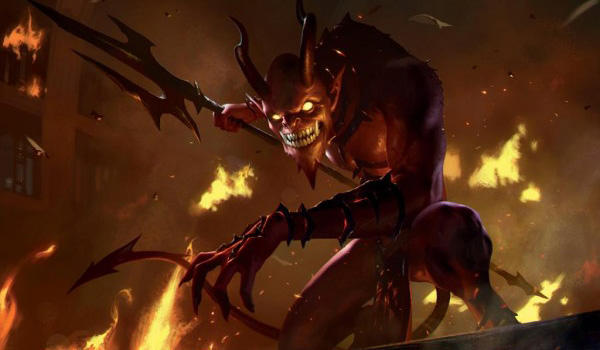
That isn't to say these cards are unplayable, or that they can't serve a significant purpose, whether in Standard, Modern, Limited or anywhere else. Sin Prodder, for example, has shown up here and there in a couple Modern decks---but it hasn't turned into the format-defining staple some thought it would. What I want to focus on today is the fallacy that's at the heart of these mis-evaluations, and examine how it can guide our hand in understanding card selection more broadly. What it all boils down to is a related underestimation of the importance of something very fundamental to Magic---choice.
[wp_ad_camp_1]
Why Choice Matters
As a variance-based game, Magic presents lots of unexpected situations that a deckbuilder can't account for ahead of time. Role assignment, one of the single-most important strategic considerations in the game, may shift based on matchup, particular draws, mana screw, or even the presence/absence of a single card in a deck. 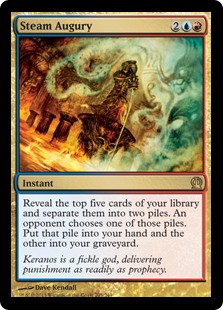 You don't know before beginning a game if you'll draw 10 lands or 2. You don't know what your opponent will be playing. You won't know how they've chosen to fill whatever flex slots are offered by their archetype.
You don't know before beginning a game if you'll draw 10 lands or 2. You don't know what your opponent will be playing. You won't know how they've chosen to fill whatever flex slots are offered by their archetype.
If misassignment of role equates to game loss, that must necessarily be mediated through our in-game decisions. We attack when we should be blocking, value card advantage when we should value board presence, waste a kill spell on their threat that we should ignore, etc. Implied in all this is that our cards offer us these choices. If we imagine a hypothetical deck where every card functions the exact same way every time, we can easily see how this strategy will be unlikely to take down tournaments. Of course normal Magic decks, and cards, are nowhere near this polarized, but we can see the principle in action in a few places. A classic example would be the creature that can't block. If we correctly identify our role in the matchup as the control, it doesn't matter much to this card---you still have to turn it sideways.
As a highly-linear format with powerful internal synergies, Modern presents many decks that make use of these more narrow cards. 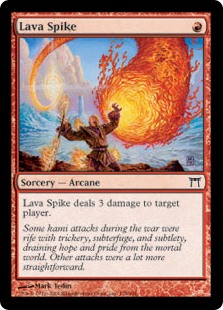 Almost every archetype outside of midrange and control plays something in this vein, from Lava Spike in Burn to Distortion Strike in Infect, to Fulminator Mage in Living End. In fact, if your deck doesn't operate on a highly specialized axis (again assuming you're aiming to beat down in most matchups), there's a fair chance it's just not good enough.
Almost every archetype outside of midrange and control plays something in this vein, from Lava Spike in Burn to Distortion Strike in Infect, to Fulminator Mage in Living End. In fact, if your deck doesn't operate on a highly specialized axis (again assuming you're aiming to beat down in most matchups), there's a fair chance it's just not good enough.
But all of these linear decks pack a significant number of more flexible cards which offer many choices to their pilots. When Burn faces another aggressive deck, Eidolon of the Great Revel becomes one of the most skill-intensive cards to play correctly. Sometimes you attack with it and offer the trade before casting spells; sometimes you leave it back to block; sometimes you choose to neither attack nor block. Similarly, Atarka's Command presents a myriad of crucial decisions that can make the difference between winning and losing---do you fire it off when they're tapped out? Wait until you can deploy an additional creature? Or leave it up for when they try to Obstinate Baloth or Siege Rhino you?
 It's no coincidence that these cards are among the most powerful in Burn's arsenal. Certainly their raw rate is relevant to their power level. But the options inherent in them are a fundamental aspect as well, allowing the pilot to adapt to situations, outplay opponents, and respond to unexpected card choices or unlikely scenarios that may arise. Consider the example of something like Flame Rift in comparison to Atarka's Command. The rates are pretty close. While Command can at times hit for 5+, Rift is never dependent on a creature in the red zone for its 4 damage. But it should be painfully obvious which of these cards is better---the flexibility of Command just blows Flame Rift's rigid single-mindedness out of the water.
It's no coincidence that these cards are among the most powerful in Burn's arsenal. Certainly their raw rate is relevant to their power level. But the options inherent in them are a fundamental aspect as well, allowing the pilot to adapt to situations, outplay opponents, and respond to unexpected card choices or unlikely scenarios that may arise. Consider the example of something like Flame Rift in comparison to Atarka's Command. The rates are pretty close. While Command can at times hit for 5+, Rift is never dependent on a creature in the red zone for its 4 damage. But it should be painfully obvious which of these cards is better---the flexibility of Command just blows Flame Rift's rigid single-mindedness out of the water.
Assessing Power Level
If we can see how options on a card tend to push up its utility and playability, it's way easier to see why the punisher mechanic is so poor in competitive play. If options are good for us, they're good for our opponent as well! Putting a punisher card in your deck actively increases the number of opportunities your opponent has to adapt to whatever form the game takes on. And if every match is a zero sum game, that means it's almost like you gave yourself a negative choice.
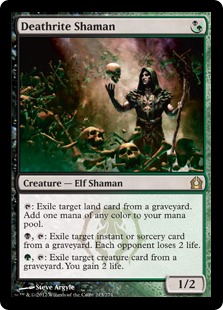 When building decks, selecting specific sideboard cards, or evaluating new cards for constructed playability, these inherent options in the cards should be at the forefront of our minds. Again, that doesn't mean a punisher card can't be good, nor that a card with numerous options is necessarily great. But it can help contextualize our card evaluation, as a sort of "modifier" to whatever value we assign to the card's baseline. This can help us understand and predict better how a given card will perform.
When building decks, selecting specific sideboard cards, or evaluating new cards for constructed playability, these inherent options in the cards should be at the forefront of our minds. Again, that doesn't mean a punisher card can't be good, nor that a card with numerous options is necessarily great. But it can help contextualize our card evaluation, as a sort of "modifier" to whatever value we assign to the card's baseline. This can help us understand and predict better how a given card will perform.
Take Deathrite Shaman, for instance. This card would go on to utterly dominate Modern, eventually meriting a ban, but it was sluggish to catch on. People paid it little notice during spoiler season until Pro Tour Return to Ravnica proved the card's pedigree. Even then, not every team had found the card and some ran it as a two-of. Even BGx mastermind Wily Edel, who top-eighted the event, did so without any copies. How did the community at large (the pro community, no less) miss the unbelievable power level of Deathrite Shaman?
I think it's because it was initially regarded as a "bad Birds of Paradise." This certainly is an apt description---Birds makes mana every turn, no matter what, while Deathrite requires a steady stream of fetchlands to serve its primary purpose. As a gloss for understanding the card, the "bad Birds" narrative de-emphasized the truly broken aspect of the card---this is a one-drop mana accelerant that can easily win the game by itself. 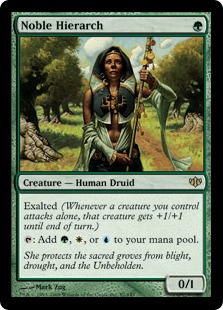 Even multi-format all-star Noble Hierarch contributes a mere 1 point of damage to your clock each turn---Deathrite doubles up on that output, all while serving as life gain when you've fallen behind and randomly hosing graveyard strategies! You can see why it ended up earning the cheeky reputation of "one-mana planeswalker"---it was nearly impossible to construct a scenario or board-state where Deathrite wasn't excellent. It just did too much, too easily.
Even multi-format all-star Noble Hierarch contributes a mere 1 point of damage to your clock each turn---Deathrite doubles up on that output, all while serving as life gain when you've fallen behind and randomly hosing graveyard strategies! You can see why it ended up earning the cheeky reputation of "one-mana planeswalker"---it was nearly impossible to construct a scenario or board-state where Deathrite wasn't excellent. It just did too much, too easily.
Another more recent example that can be instructive is Nahiri, the Harbinger. Modern players weren't clamoring for a four-mana Disenchant before, and Through the Breach for Emrakul, the Aeons Torn has been an available line for some time which has seen only limited adoption. It's true that Nahiri's most unique contribution, the ability to tutor up Emmy so we don't have to clog our deck with four copies, is also her most powerful. But the additional utility provided by the looting ability and the Disenchant effect is what makes her playable.
If her text was merely "Suspend 2 -- Fetch up Emrakul," she would be unlikely to see any play at all. As it stands she grants her pilot ample options depending what stage the game is in. Need to kill fast to race their combo or topdecks? Plus into Emmy. Need to find specific answers? Loot away garbage. 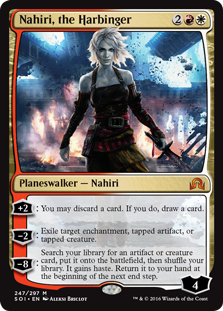 Noncreature permanent or tapped Tarmogoyf cramping your style? Get it out of there.
Noncreature permanent or tapped Tarmogoyf cramping your style? Get it out of there.
So on both Nahiri and Deathrite, any one of the abilities is anemic by itself. The would-be evaluator of these cards who got it right at the outset needed to recognize how the combination of their abilities constituted a strategic advantage in itself. Applying these lessons to future card evaluations shouldn't be hard. Adjust down for severely restricted options, or for options granted to the opponent; adjust up for flexibility and options granted to us.
Finding the "Secret" Mode
Sometimes the options granted by a specific card are less obvious than they appear at first glance. Understanding all of the different, sometimes counterintuitive ways to play a card can confer a distinct advantage on a player. Some obvious examples would be using removal to kill your own Dark Confidant, lest Mr. Maher nugs you for lethal on upkeep, or Bolting a planeswalker, or saccing your Ravager to fizzle an effect. These are all well-documented and understood plays in Modern, and need no introduction. 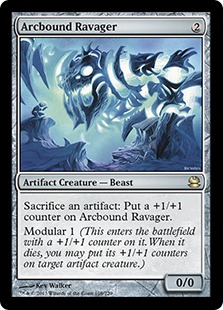 What I want to look at is something that's simultaneously much more omnipresent and much less understood. I speak, of course, of the fetchland.
What I want to look at is something that's simultaneously much more omnipresent and much less understood. I speak, of course, of the fetchland.
At first glance, it might appear that fetchlands are merely tri- or quad-color mana fixers, depending on the deck they appear in. But fetchlands are way, way better than that. To begin with, they fetch up basic lands to play around Ghost Quarter, Blood Moon or Choke. They allow canny pilots to carefully manage their draw step (or alternately bungle it up) depending on how they're sequenced alongside cantrips. They find Dryad Arbor for anti-Liliana technology or regular-damage kills in Infect. They shrink our life total if we're so inclined to make for massive Death's Shadows.
Learning how to fetch correctly is one of the first bars a new Modern player has to clear to become competent in the format. But even for seasoned veterans it can be one of the more challenging aspects of tight play. 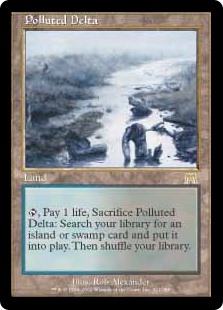 These seemingly innocuous and obvious cards actually present a whole litany of opportunities for both misplay and genius alike, and your familiarity with the marginal lines can be the difference between a match win or loss.
These seemingly innocuous and obvious cards actually present a whole litany of opportunities for both misplay and genius alike, and your familiarity with the marginal lines can be the difference between a match win or loss.
If something as simple as a fetchland can present these decision points, you better believe other cards in your favorite deck or archetype do too. These hidden modes on cards (especially in a format as deep and varied as Modern) are one of the main reasons that archetype familiarity is so important. You can certainly take the tack of playing a given deck into the ground, to force yourself to be confronted with all the different scenarios. But you can also take a more active approach---look at the board state and ask, "Is there another way I can use this card?" You may be surprised what you come up with.
The Sideboard Bullet vs. Generic Card
Finally, we get to another point I've found contentious in Modern theorizing. Personally I love the generic sideboard card with wide applications; others have explained the importance of the more narrow cards. There are times when these silver bullets are the only option available, either to combat a highly linear deck, or to turn a bad matchup winnable. 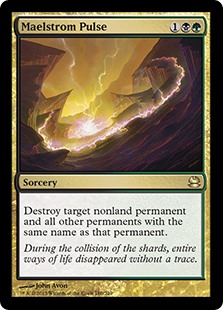 This aspect of Modern is unlikely to change anytime soon, as long as diversity remains high and the format remains linear.
This aspect of Modern is unlikely to change anytime soon, as long as diversity remains high and the format remains linear.
But I look at them more as a necessary evil than a tool I'm happy to spend a sideboard slot on. Certainly if you're trying to Jund people you may want to jam some Fulminator Mages or Crumble to Dusts (maybe even Blood Moons if you're ambitious) into the sideboard to combat one of your worst matchups (Tron). But don't leave those more generic sideboard cards at home. The Negates and Maelstrom Pulses of the world can buy you lots of percentage points simply by being so flexible, and allowing you to out-decision opponents who have chosen to show up with fewer options available.
In my mind, the importance of having options lies at the heart of competitive Magic, but I run across people who value it lower than me all the time. What are your thoughts? Have I overstated the importance of flexibility in a format so characterized by single-minded strategies as Modern? What cards do you think may be under- or overrated for their flexibility or lack thereof? I look forward to your comments below.
Thanks for reading,
Jason Schousboe


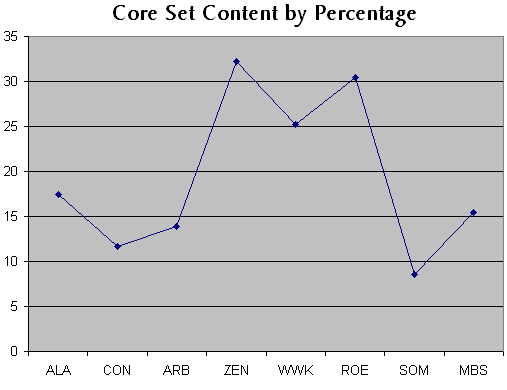


The importance of choice—and of not giving opponents choice—is something good Magic players understand inherently, like grammar rules for native English speakers. This article explains why choices are so important very elegantly, and in specific relation to Modern, to boot. Thanks for a fantastic piece!
Great article.
I have always found Izzet Charm to be a superb option in modern, despite falling out of favour somewhat. It’s cooler cousin, electrolyze, always gets the girls, but I recognise a good spell when I see one.
Wow! I really liked this article. Well said and well done.
My personal favorite underrated options card that sees Modern play off and on is Golgari Charm. While it’s easy to see the charm as a sweeper with a few mild possibilities, I find the regeneration clause at the very least highly versatile and applicable to a wide variety of combat situations in Modern. Speaking of lines of play, blocking and regenerating with a smaller board presence nets you a Fog, which might free up enough windows to attack yourself for the win.
Golgari Charm is a nasty card against my pet deck. It wrecks all the X/1s that D&T runs.
I enjoy the relative strength of side boarding for general answers. I’ve always felt that Runed Halo was a great bit of side (or even main) board protection.